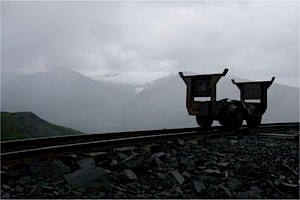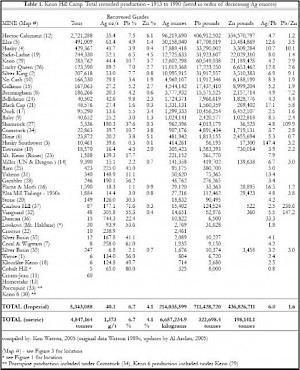 The legendary Keno Hill Camp in the Yukon Territory was host to Canada's second largest primary silver producer and one of the richest Ag-Pb-Zn vein deposits ever mined in the world. Following a small amount of hand mining between 1913 and 1917, larger scale production was almost continuous from 1919 to 1989 with over 200 million ounces of silver was produced at an average grade of 1373 grams per tonne.
The legendary Keno Hill Camp in the Yukon Territory was host to Canada's second largest primary silver producer and one of the richest Ag-Pb-Zn vein deposits ever mined in the world. Following a small amount of hand mining between 1913 and 1917, larger scale production was almost continuous from 1919 to 1989 with over 200 million ounces of silver was produced at an average grade of 1373 grams per tonne.
Keno Hill produced more wealth than the Klondike, one of the richest placer gold districts in the world, and became one of the mainstays of the Yukon economy from the 1920s to 1960s, following the end of the gold rush. Larger scale and mechanized production was virtually continuous from 1919 to 1989, with Treadwell Yukon Corp. Ltd. and United Keno Hill Mines Ltd. (UKHM) producing the majority of ore. Both companies went bankrupt due to a period of sustained low silver prices.
 In 2006, Alexco Resource Corp purchased the United Keno Hill Mines claims, which encompassed the western portion of the district, and commenced exploration which initially focused on the area associated with the Bellekeno Mine. In March 2019, Alexco published results of a Prefeasibility study which cited life of mine grade exceeding 804 grams/tonne.
In 2006, Alexco Resource Corp purchased the United Keno Hill Mines claims, which encompassed the western portion of the district, and commenced exploration which initially focused on the area associated with the Bellekeno Mine. In March 2019, Alexco published results of a Prefeasibility study which cited life of mine grade exceeding 804 grams/tonne.
The eastern portion of the district, which hosted eight former producing mines and five with the highest-grade, was never acquired by UKHM, but remained held by numerous, disparate private groups and families who maintained their claims in good standing for decades. Metallic Minerals has consolidated the majority of this area and currently holds the second largest land package in the district at 166 square kilometres.
Although staked for its silver mineralization, the Keno Hill property is located within the Tintina gold belt, a zone of gold deposits associated with Cretaceous Tombstone suite granitic intrusions. Significant deposits hosted within the Tintina gold belt include Victoria Gold's nearby Eagle Gold & Dublin Gulch, Golden Predator's Brewery Creek, Rockhaven's Klaza project, in addition to numerous prospects including Gold Dome, Clear Creek and Red Mountain and others.
History of the Keno Hill Silver District
- 1898 Placer gold discovery in Duncan Creek brought prospectors from the Klondike goldfields.
- 1902 Mayo township established.
- 1903 Argentiferous galena discovered at Silver King and mined 1913‐1917.
- 1918 Argentiferous galena discovered on Keno Hill.
- 1919 Keno Hill Ltd staked claims on Keno Hill.
- 1920 Keno City established.
- Grades had to be more than 125 oz/t to be economic, cost of horse transport to Mayo the same as to smelters in US.
- 1921 Treadwell Yukon Company acquired claims at Sadie Ladue on Keno Hill.
- 1925 Treadwell established mill at Sadie Ladue. Bulldozers significantly reduced the cost of ore haulage.
- 1927 Treadwell acquired Lucky Queen high grade mine.
- All operations suspended in 1932 during Depression.
- 1934 Treadwell Yukon acquired all the Keno Hill Ltd properties.
- 1924 Elsa vein discovered on Galena Hill, re‐opening of Silver King and discovery of Hector–Calumet, and optioned by Treadwell Yukon.
- 1935 Mill moved to Elsa and mining continued until 1941 when all work ceased and equipment was sold to US Army for construction of Alaska Highway during World War II.
- Livingstone Wernecke had led Yukon Treadwell and produced 44 Moz silver with 80% milled at 60 oz/t and 20% hand-sorted at 340 oz/t. 60% of production came from Keno Hill.
- 1946 Treadwell Yukon assets purchased by Keno Hill Mining Company, later named United Keno Hill Mines (UKHM), and mill began re‐operating. Power was generated from coal mine purchased in Carmacks, and transport was improved by the government building the Whitehorse – Mayo road.
- 1951 New discoveries at Hector‐Calumet led to construction of a town and a new mill built at Elsa, with power supplied from a new hydro plant in Mayo.
- UKHM’s success bought new companies to the district and another mill was built at Mackeno near Christal Lake.
- 1950 Zinc recovery became economic.
- New exploration from 1963 led to the discovery of the Husky deposit in 1970 just as the Hector‐Calumet was closing.
- At peak in 1960’s UKHM had 600 employees, and with families, supported about 20% of the Yukon population. The operation also kept the White Pass Railway going and was responsible for the development of the Mayo airport.
- 1972 Husky Mine commenced production.
- 1977 Economics became uncertain due to fluctuations in silver price, open pit mining commenced unsuccessfully.
- 1982 ‐ 1989 Small scale tribute mining continued until UKHM closed.
- 1990 ‐ 1998 Dominion Mineral Resources and Sterling Frontier Properties acquired 32% of UKHM, conducted exploration but were unsuccessful in reopening mines; rights reverted to UKHM but environmental liabilities and site maintenance drove UKHM bankrupt. Federal government inherited assets.
- 2006 Alexco Resource Corp purchased the UKHM property.
- 2010 Metallic Minerals predecessor acquired Keno Hill claims.
- 2017 Metallic Minerals added to its land position, nearly tripling its total Keno Hill Silver District holdings to 166 square kilometres.
References
1The material scientific and technical information in respect of Alexco’s Keno Hill Silver District Project is based upon information contained in the technical report dated March 28, 2017, entitled “Alexco and Silver Wheaton Amend Silver Purchase Agreement and Alexco Announces Positive Preliminary Economic Assessment for Expanded Silver Production at Keno Hill” which is available under Alexco’s profile on Sedar.com.
2Cathro, R.J. 2006, Great Mining Camps of Canada 1.The History and Geology of the Keno Hill Silver Camp, Yukon Territory, Geoscience Canada, v. 3
 The legendary Keno Hill Camp in the Yukon Territory was host to Canada's second largest primary silver producer and one of the richest Ag-Pb-Zn vein deposits ever mined in the world. Following a small amount of hand mining between 1913 and 1917, larger scale production was almost continuous from 1919 to 1989 with over 200 million ounces of silver was produced at an average grade of 1373 grams per tonne.
The legendary Keno Hill Camp in the Yukon Territory was host to Canada's second largest primary silver producer and one of the richest Ag-Pb-Zn vein deposits ever mined in the world. Following a small amount of hand mining between 1913 and 1917, larger scale production was almost continuous from 1919 to 1989 with over 200 million ounces of silver was produced at an average grade of 1373 grams per tonne.  In 2006, Alexco Resource Corp purchased the United Keno Hill Mines claims, which encompassed the western portion of the district, and commenced exploration which initially focused on the area associated with the Bellekeno Mine. In March 2019, Alexco published results of a Prefeasibility study which cited life of mine grade exceeding 804 grams/tonne.
In 2006, Alexco Resource Corp purchased the United Keno Hill Mines claims, which encompassed the western portion of the district, and commenced exploration which initially focused on the area associated with the Bellekeno Mine. In March 2019, Alexco published results of a Prefeasibility study which cited life of mine grade exceeding 804 grams/tonne.